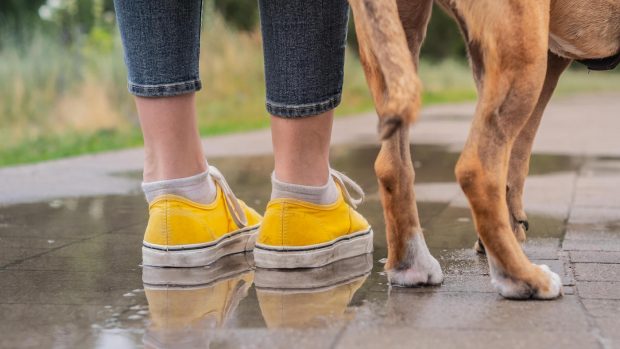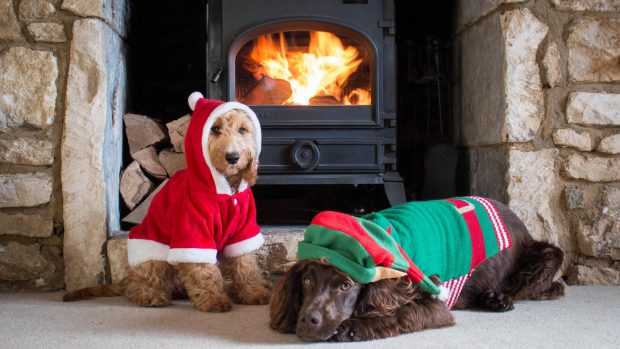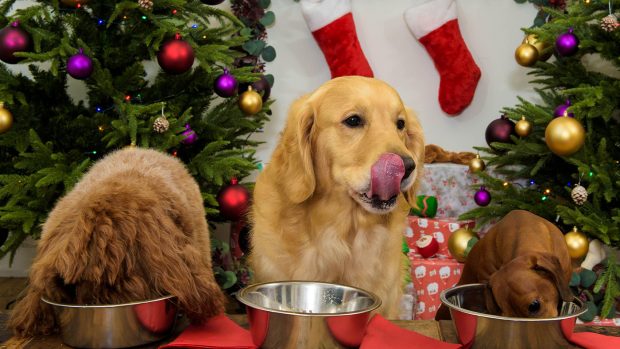Having an anxious dog does not only have a negative effect on your dog himself, but it can cause great stress for you and other members of the household – those with four legs as well as two. It’s important to make sure that your behaviour isn’t unintentionally reinforcing the anxiety. You’ll be pleased to know that it’s possible to help dogs overcome anxieties – or at least cope with them in a conducive and positive way, often with the help of dog calming products – and this starts with determining the root cause of the anxiety.
Does my dog have anxiety?
If your dog shows any of the following signs, they may be caused by anxiety:
- Aggression
- Urinating or defecating in the house
- Drooling
- Panting
- Destructive behaviour and chewing
- Depression
- Excessive barking
- Pacing
- Restlessness
- Repetitive or compulsive behaviours
- Vomiting
If you’re unsure on how to help an anxious dog or are dealing with a puppy in the fear stages, enlist the help of a behaviourist from the beginning to help you understand, teach and deal with all the issues a dog may have growing up along the way. Fear stages are the trickiest to navigate and should you see signs of anxiety signs in your puppy or dog, seek professional help immediately – avoid taking advice from your friend’s sister’s boyfriend as incorrect advice takes a lot of undoing and hard work to get the dog to a happier place.
Why do dogs get anxious?
There are numerous reasons and causes for dog anxiety, including genetics, trauma, and over- or under-socialising. Not understanding your dog’s anxiety and continually putting him in an environment that he finds difficult and negative will only serve to reinforce the anxiety.
Mental and psychological conditions
Like humans, dogs can suffer mental health issues but will display them in different ways. They can show obsessive compulsive disorders, depression and anxiety, as well as physical ailments, such as chewing their paws and tail, chasing their tail, obsessive licking, pacing or not being able to settle.
Fear anxiety
Fear anxiety can be caused by loud noises, unknown people or animals, visual stimuli (a particular object, such as an umbrella), novel environments, specific situations (such as a trip to the vets) or surfaces like grass or wood floors. They are usually due to a traumatic event that occurs during the fear stages of their development. However, it can still occur at any age if the trauma is sufficient – for example, being attacked several times on a lead. This usually develops into the dog becoming reactive in the presence of others dogs, panicking, trying to bolt and sometimes even soiling itself due to fear. With the help of a good behaviourist, patience, consistency and time, this can be overcome with modification techniques.
Desensitisation and lifestyle adjustment is key. I suggest working on the “two days off, one day on” routine, where (if the anxiety occurs during walking) you walk in positive places (where you are less likely to encounter the triggers) for two days and then on the third day you must work on the desensitisation and modification techniques.
There are also lots of different dog calming products available, including Thunder Shirts (available on Amazon) can help dogs that are afraid, along with weighted dog vests (like this one on Amazon) and weighted blankets (also on Amazon).

ThunderShirt | Amazon.co.uk
Available in five sizes, this naturally calming wrap-around shirt is more than 80% effective.

Weighted Dog Blanket | Amazon.co.uk
This soft and reversible weighted blanket helps to reduce anxiety and promote feelings of security.
Separation anxiety
This is probably one of the most common anxieties seen in dogs and occurs when a dog is unable to find comfort when they are left alone or separated from their family members. This anxiety often manifests itself in undesirable behaviours, such as urinating and defecating in the house, destroying furniture and furnishings (find out how to stop dogs chewing), and barking (find out how to stop dogs barking). It can also show through excessive excitement upon your return or signs of stress before you leave, such as not coming in or bolting out of the door.
There are several ways to counteract this and it’s not one size fits all. Some dogs love to be crated (find out how to crate train) with a lick mat (like this one on Amazon) and a favourite toy, together with something that may smell of you, their crate covered, and a radio left on. Adaptil plug ins (available on Amazon), sprays and calming dog supplements can certainly help, but they don’t work for all. Some dogs may prefer one room with a baby gate across the door and a calming dog bed in the corner, while other dogs may be happier lying on your bed or having the whole run of the house, providing there is no excessive barking or howling upsetting the neighbours. Much of it is a case of trying different things.

Adaptil Calming Spray | Amazon.co.uk
This spray contains a synthetic copy of the “dog appeasing pheromone”, which a mother naturally releases to calm and reassure her litter.

Zylkene Calming Supplement | Amazon.co.uk
Contains alpha caseophine – a natural milk protein with clinically proven calming properties – and can easily be sprinkled on to food.
Depression
Depression can exhibit itself in several ways. Dogs can feel extreme sadness due to the loss of their owner and can take a while to adjust. Signs of depression include appetite loss, lethargy, not sleeping or sleeping too much, dander on their coats and general withdrawal from life. It’s usually temporary – often coming after a life-changing event or loss – and will often resolve itself as the dog adjusts to its new life. Dog calming tablets, such as Zyklene (found here on Amazon) and Adaptil (also on Amazon) can help with this process.
Compulsive behaviours
Compulsive behaviours are somewhat more challenging – and signs can include barking, chewing, excessive licking, pacing, spinning, air snapping, shadow chasing or tail chasing. These behaviours can start out as self-soothing responses, but become problematic when they become rituals. For example, a dog may chew their favourite toy when they hear fireworks, but then they begin searching for the toy anytime they feel slightly scared or anxious.
Some behaviours can be harmful – dogs can self-mutilate by licking or chewing their paws or sides constantly, or even chasing and biting their tails to the point that they require amputation. These behaviours are becoming increasingly common and require veterinary intervention alongside training and behaviour modification.
Genetic disposition
Studies have indicated that unwanted behaviour seems to be inherited, which means that, through careful breeding that relies on suitable behaviour indicators, the prevalence of such behaviour traits could be decreased. This would improve the quality of life not only for the dogs but their owners, too. For example, if you have a nervous fearful bitch, putting her to an equally highly strung, fearful or aggressive male is likely going to produce a litter of predominantly the same traits. Although nothing is guaranteed it would be remiss and irresponsible.
Wherever possible, make sure you get to see the mum with her litter if you’re buying a puppy. Bitches can have altered behaviour when they have pups, but by the time the litter is six weeks old you should have a good indication of her natural disposition. Red flags include a bitch backing away, shaking or even urinating when seeing strangers, growling and whale-eyed (with the whites visible) or completely shut down and disengaged. It is not always possible to see a sire as they are often owned by other breeders. Do your research and ask lots of questions.
Some breeds are more likely to suffer with anxiety, and these include (but are not limited to) the following:
- Cockerpoos, cavapoos and most mixed poodle breeds
- Rescue dogs/street dogs bought into a domestic environment
- Miniature dachshunds
- Jack Russell Terriers
- Shih-tzu
- Chihuahua
- Lurchers, whippets and greyhounds
- German Shepherds
- Border Collies
- Cocker spaniels
You might also be interested in:

Canine calming products to keep your dog cool, calm and collected

Soothe anxiety with the best calming supplements for dogs

Curled up and cosy: the best donut beds for dogs

No more yapping: how to stop a dog nuisance barking

How to stop your dog chewing your home to shreds

How to stop a puppy crying so that everyone gets a good night’s sleep

Teeth off! The best sprays to stop dogs chewing

Subscribe to Horse & Hound magazine today – and enjoy unlimited website access all year round
Horse & Hound magazine, out every Thursday, is packed with all the latest news and reports, as well as interviews, specials, nostalgia, vet and training advice. Find how you can enjoy the magazine delivered to your door every week, plus options to upgrade your subscription to access our online service that brings you breaking news and reports as well as other benefits.




